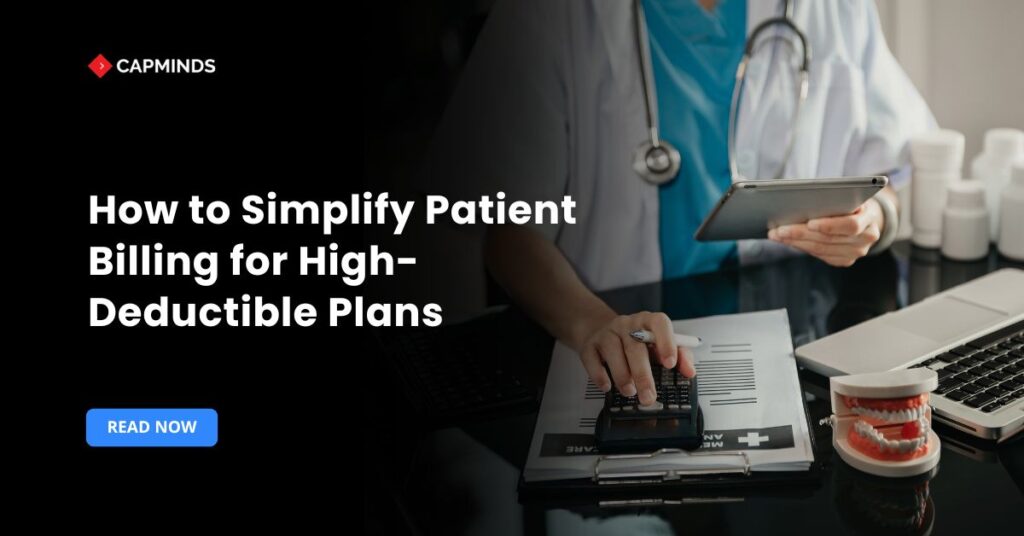How to Simplify Patient Billing for High-Deductible Plans
High-deductible health plans (HDHPs) are now common – roughly half of U.S. workers in private plans carry an HDHP. While these plans lower premiums, they shift more cost burden to patients at the outset. In fact, over the past decade premiums rose ~47% and deductibles ~53%. As a result, about 4 in 10 Americans admit they’ve delayed or skipped care due to cost pressures.
Providers feel the impact: 79% of physicians say high deductibles drive most patient cost concerns. In this environment, practices must make billing crystal clear and easy to act on. Streamlining statements, payment options, and communication can turn financial stress into a smoother experience for patients and faster collections for clinics.
Steps to Simplify Patient Billing for High-Deductible Plans
1. Communicate Clearly and Transparently
Use plain, jargon-free language. Instead of codes or technical terms, describe charges in everyday words. For example, call a copayment “your share of the visit cost”.
- Break down each charge: list base fees, labs, and any equipment or facility fees, along with how much insurance pays vs. what the patient owes.
- Highlight due dates and payment steps so nothing is buried. Structured bills should have clear headings and spacing, with the total owed and instructions easy to spot.
Patients tend to find statements confusing when they arrive late or use medical lingo. By writing bills like friendly letters, short lines, simple terms, and bold due dates, you help patients grasp their balance quickly.
If patients seem puzzled or upset about costs, listen carefully and empathize.
- Keep conversations focused on solutions, not blame. Train staff to acknowledge concerns and explain charges gently.
- For instance, if a patient worries about a high deductible, calmly offer options (see below) rather than saying “that’s just policy.”
- Provide written estimates before treatment and get patient sign-off on understanding their share.
- Consistency matters too: use the same terminology in person, on the portal, and on paper. A “service fee” online should match the wording on the printed bill.
This avoids confusion and builds trust, especially when patients with HDHPs are already anxious about costs.
2. Leverage EHR Systems and Patient Portals
Modern EHRs often include patient portals – secure online accounts where patients can view bills and pay them. These portals are a game-changer for HDHP billing. They give patients 24/7 access to statements, receipts, and payment options.
- Studies show about 67% of patients prefer paying medical bills online.
- By posting charges in the portal, providers meet that expectation.
- Patients can save a credit card or even a mobile wallet (Apple Pay, Google Pay) on file, so paying is just a few clicks.
- One provider saw a 20% jump in online payments after adding these features. Digital payments also speed revenue: payments arrive ~6.5 days sooner on average when patients use the portal.
Key portal features: Ensure your portal ties into the EHR/billing system so payments post automatically to the correct account. Allow multiple payment methods, credit/debit card, ACH bank transfer, HSA cards, or digital wallets, on one screen.
Offer installment plans directly in the portal, so a patient can split a large bill into monthly pieces. Automate reminders via email or text as well.
For example, 66% of patients prefer billing notifications by email or SMS; use the portal to send automatic e-statements and alerts. This transparency, showing itemized charges, insurance payments, and patient responsibility online, builds trust. A clear digital portal means fewer phone calls. When patients see their balance and what it covers, they ask fewer questions and pay faster.
If you don’t have a portal, consider a secure web payment solution. Many EHRs (like Practice Fusion, AdvancedMD, etc.) offer integrated payment hubs.
Choose one with PCI-compliant security and HIPAA safeguards. Mobile optimization is key too: patients often use phones or tablets, so the payment page must be easy to tap on small screens.
Related: Smart Billing Portals for Insurance, Cash & Sliding Fee (A Custom Health Tech Approach)
3. Offer Flexible Payment Options
High deductibles and unexpected costs mean many patients can’t pay in one shot. A patient payment plan can bridge the gap. A payment plan lets the patient split their bill into smaller chunks over time.
Plans can be interest-free short-term (say, 3–6 months) or longer loans with low interest, depending on your resources. Practices may manage plans in-house or use third-party financing. Third-party lenders handle credit checks and collections, often securing payment faster and reducing your paperwork.
- Even small plans help. For example, if a patient can’t cover a $1,200 procedure, let them pay $100–$200 a month rather than letting the debt go unpaid.
- Structured financing keeps care accessible and stabilizes your revenue.
- Flexible options might include interest-free installments, sliding-scale fees, early-pay discounts or even nonprofit assistance if available.
- The key is letting patients choose what fits their budget: credit/debit card, bank draft, HSA account, or digital wallet.
Veradigm reports patients want these choices. One survey found 85% of healthcare consumers prefer paying bills online, and many want to customize payment schedules.
- Train your billing team or set up an automated system to offer these plans consistently.
- For instance, your portal could present “Set up monthly payments” when showing a big balance.
- A virtual assistant or cashier can also ask: “Would you like to split this into installments?”.
- By proactively offering a plan at checkout or in follow-up emails, you avoid the patient feeling “stuck” with an unmanageable sum.
4. Engage Patients Proactively
Simplification starts before the bill arrives. Train front-office staff to verify insurance details and determine the patient’s deductible status at scheduling or check-in. Use the EHR to run eligibility and estimate the patient’s share in advance.
Then communicate early: let patients know roughly what to expect out of pocket, perhaps as part of a visit confirmation or pre-registration email. If possible, collect copays and even an upfront deductible portion when they arrive for service. Studies show over half of patients are willing to pay $200–$500 or more by card at the time of a visit.
- When a patient says they can’t pay immediately, act with empathy. Rather than a flat “You’ll get a bill,” say: “I understand this can be tough. We can set up monthly payments, or you can pay part of it today, and the rest through our portal.”
- Giving this option on the spot improves collections. Some practices collect 25–50% of the estimate at check-in and promise the rest after claims are processed.
- Always ask, “How would you like to pay your bill today?” instead of “Can you pay?” This small wording change raises collection rates.
Use multiple contact methods to remind and assist. As noted, text or email reminders dramatically boost on-time payments. Likewise, if a patient hands you a bounced check or declines, immediately send a follow-up message with a payment link.
For patients uncomfortable online, offer help: “Our virtual assistant can walk you through paying on the portal, or we can send a secure link to your phone.”
Maintain courtesy and patience; a frustrated tone only drives patients away. Document all conversations in the EHR or billing notes. This record helps follow up and shows patients you’re organized and trustworthy. Finally, review your billing performance regularly (monitor days in A/R, collection percentages, patient satisfaction surveys) and tweak processes that aren’t working.
Transform Patient Billing with CapMinds’ Digital Health Solutions
Ready to simplify billing and improve patient satisfaction? CapMinds can help you lead the way.
Our end-to-end digital health solutions empower providers to deliver a seamless billing experience, especially for patients on high-deductible health plans.
With CapMinds, you can:
- Integrate custom patient portals for real-time billing access and payments
- Deploy secure mobile apps that support payments, statements, and reminders
- Enable automated billing workflows through EHR integration
- Offer flexible payment plans and options that patients want
- Engage patients proactively with alerts, SMS, and digital estimates
From strategy to implementation, CapMinds delivers HIPAA-compliant solutions tailored for modern healthcare practices. Let’s help you reduce administrative overhead, accelerate collections, and build trust with every patient interaction.
Get in touch today to see how CapMinds can transform your billing experience, because your patients deserve simplicity, and your practice deserves results.




